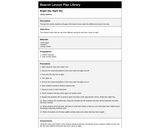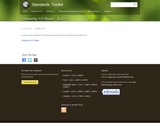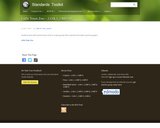
To discover, understand, and compare/contrast cultural conventions in the target culture with students’ culture.
- Subject:
- World Languages
- Material Type:
- Activity/Lab
- Author:
- William Allred
- Carrie Robledo
- Date Added:
- 05/18/2021

To discover, understand, and compare/contrast cultural conventions in the target culture with students’ culture.

This article discusses the four forms of identifying similarities and differences: comparing, classifying, creating metaphors, and creating analogies and how these strategies can be used in an elementary classroom.

Students will explore the difference between wants and needs as they decide what they will be taking to Grandma's house. Students will recognize that people have basic needs (food, shelter, and clothing) and wants (toys, games, treats). The assessment plan attachments includes wants and needs chart and picture cards.

This lesson exposes children to a variety of animals and guides them through observation of animal similarities, differences, and environmental adaptations. This lesson can be used as part of a study of plants and animals. Before doing the lesson, students should know the meanings of the terms plant, animal, and living.

In this activity, students will make observations and understand that the sky looks different during the day than it does at night.

A great lesson plan for an author study on Leo Lionni, the award winning author of several children's literature.

This lesson focuses on the film adapatation of The Color Purple, by Alice Walker. After reading the novel, students watch the movie in class and compare the two. Students compare and contrast the two versions of the story in writing at the end of the lesson.

In this assessment task students are asked to use a Venn Diagram to compare 3-D solid shapes. Students are given a cube and a cylinder. They are asked how the shapes are the same and how they are different. Teachers can dictate student responses. An assessment sheet and rubric are provided.

Students compare two decimals to hundredths by reasoning about their size, recognize that comparisons are valid only when the two decimals refer to the same whole, and record the results of comparisons with the symbols >, <, or =.

In this lesson plan, students are given various activities that will require them to compare and order fractions.

This lesson is Day 10 in a series of 12 lessons around fraction equivalences and comparisons.
This video lesson serves as a review of equpartitioning in order to determine the fractional part of an area or length. This is a necessary foundational skill for comparing and finding equivalent fractions.

This lesson is Day 11 in a series of 12 lessons around fraction equivalences and comparisons.
This video lesson reviews parts of a whole, comparing fractions, and equivalent fractions. No materials are needed.

This lesson is Day 12 in a series of 12 lessons around fraction equivalences and comparisons.
Use your math skills to help detectives solve the crime. This video lesson reviews fractions of an area, fractions on a number line, and equivalent fractions. No materials are required.

This lesson is Day 1 in a series of 12 lessons around fraction equivalences and comparisons.
This video lesson encourages students to reason about and visualize fractions. The lesson focuses on the ideas that fractions are fair shares and that fractions can be compared. This lesson assumes that students have some initial experiences with fractions.

This lesson is Day 6 in a series of 12 lessons around fraction equivalences and comparisons.
This video lesson teaches students how to create bar models to compare lengths/distances. Students will need a piece of paper, ruler, scissors, and a pencil. These bar models will also be used for Day 7's lesson.

This video lesson introduces the idea that when comparing two fractions, they must refer to the same size whole. Then, students use fraction strips to compare fractions. Students may use virtual fraction strips from Toy Theater (https://toytheater.com/fraction-strips/)

This lesson is Day 8 in a series of 12 lessons around fraction equivalences and comparisons.
This video lesson introduces the number as a tool for representing and comparing fractions. Students will need a black piece of a paper and a pencil with a good eraser.

This article provides links to standards-based science and literacy lessons about weather, climate, polar climates, and climate change.

This article discusses the research-based strategy of identifying similarities and differences and provides links to web sites to develop teacher's content knowledge.

In this assessment task students will use data to create a picture graph and a bar graph. They will sort pictures into four categories. They also answer questions to compare the animals they graphed using addition and subtraction problems. An assessment task sheet and rubric are provided.